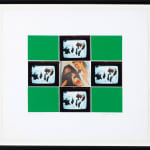Rasheed Araeen
Just a Smoke Sister, 1993
Collage on paper
46 x 58 cm
18 1/8 x 22 7/8 in
18 1/8 x 22 7/8 in
Signed and dated 'Rasheed Araeen 3/4/93' and titled 'Just a Smoke Sister' along lower edge
Further images
From the mid-1980s to the early 1990 – in the context of the ebbing of Third World struggle, the end of the Cold War, the consolidation of a restructured capitalism,...
From the mid-1980s to the early 1990 – in the context of the ebbing of Third World struggle, the end of the Cold War, the consolidation of a restructured capitalism, and a new round of imperialist wars – Araeen made a series of artworks that have since been dubbed his ‘cruciform’ works.
Araeen has emphasized procedure in the making of his subsequent ‘cruciform’ works, which he describes as a process of ‘cutting’ and ‘rupturing’ a green-coloured monochrome. Making a horizontal and vertical cut through the middle of the monochrome in the shape of a cross, Araeen would then separate out the four sections and ‘fill’ the cross-shaped cavity with a range of material he considered ‘incongruent to the purity of Minimalism.’ If Lucio Fontana signals the limits of Western modernist painting, rendering material the historical and ideological nature of the medium – albeit negatively, through slashes and perforations – in his ‘cruciform’ works, Araeen uses the same destructive procedure to indicate the limits of Western modernity itself, pointing at the global structures on which it was founded: colonialism, imperialism, and their attendant mechanisms of abjection. While Fontana’s act belongs to the era of high modernism, before the crumbling of Western colonialism had really begun, Araeen’s embodies disillusionment with both Western modernism and with the outcomes of Third World struggle.
Araeen has emphasized procedure in the making of his subsequent ‘cruciform’ works, which he describes as a process of ‘cutting’ and ‘rupturing’ a green-coloured monochrome. Making a horizontal and vertical cut through the middle of the monochrome in the shape of a cross, Araeen would then separate out the four sections and ‘fill’ the cross-shaped cavity with a range of material he considered ‘incongruent to the purity of Minimalism.’ If Lucio Fontana signals the limits of Western modernist painting, rendering material the historical and ideological nature of the medium – albeit negatively, through slashes and perforations – in his ‘cruciform’ works, Araeen uses the same destructive procedure to indicate the limits of Western modernity itself, pointing at the global structures on which it was founded: colonialism, imperialism, and their attendant mechanisms of abjection. While Fontana’s act belongs to the era of high modernism, before the crumbling of Western colonialism had really begun, Araeen’s embodies disillusionment with both Western modernism and with the outcomes of Third World struggle.
Exhibitions
Grosvenor Gallery, London, Rasheed Araeen, Sixty-Three Years of the Figural, held at Frieze, No. 9 Cork Street, 29 June - 15 July 2023, LondonRWA, Bristol, Rasheed Araeen, Conscious Forms, May - August 2024
Cambridge, The Heong Gallery, Rasheed Araeen: A British Story, 18 October 2024 – 2 February 2025, (illustrated in the exhibition catalogue)








